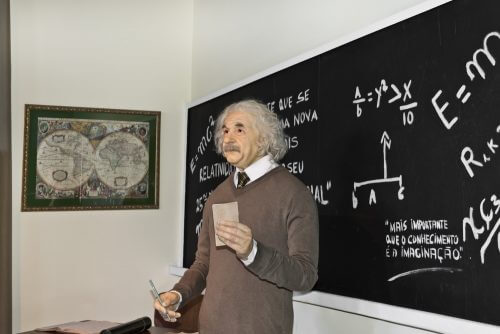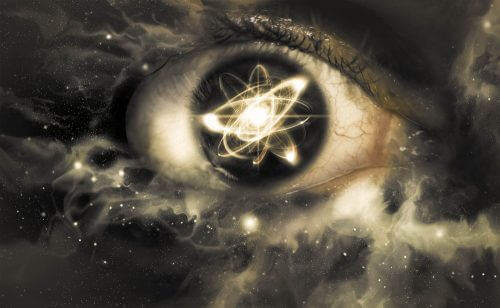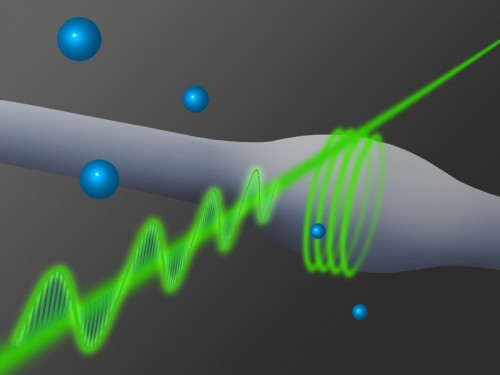One of Einstein's most enduring contributions to physics was his use of Gedankenexperiments, thought experiments * Einstein's thought experiments left a long legacy but with somewhat mixed impact / Sabin Hossenfelder

The article was published with the approval of Scientific American Israel and the Ort Israel network
Gdansk experiment, "Thought experiment" in German, was the famous name Einstein gave to the imaginations that led to his greatest breakthroughs in physics. He attributed his insight into the constant speed of light with respect to each observer, the idea at the heart of special relativity, to his youth, when he dreamed during the day that he was riding on top of a beam of light. General relativity, his monumental theory of gravity, originates from his reflections on going up and down in an elevator. In both cases, Einstein came up with new theories about the world from observing things in his mind's eye, an observation that breaks the limits set by laboratory measurements.
Einstein was not the first theorist to do so, nor the last, but his extraordinary achievements played a central role in establishing the Gedanken experiment as a cornerstone of modern theoretical physics. Today, physicists regularly use thought experiments to invent new theories and to find contradictions in existing theories or their new results.
But the modern acceptance of the thought experiment raises some poignant questions. In the search for the grand unified theory that will connect the tiny world of quantum mechanics with Einstein's relativistic description of the universe on a large scale, the most popular ideas today are not supported by observations or actual experiment. Can they exist on thought alone? How far can you go just based on logical difficulties? Where is the line between scientific intuition and wild imagination? Einstein's legacy does not offer certain answers: on the one hand, his reliance on the power of thought was a resounding success. On the other hand, many of his most famous thought experiments were based on data from actual experiments, such as the classic Michelson-Morley experiment that first showed that the speed of light is constant relative to any observer. Moreover, Einstein's insistence on measurable quantities sometimes hid from him deeper layers of reality, although even the mistakes he made in thought experiments later contributed to other breakthroughs.
In this article we will describe some of Einstein's most iconic thought experiments and clarify how they succeeded, how they failed and how they are still essential to the discussion of questions at the forefront of theoretical physics.
An elevator without windows
In the thought experiments, Einstein's genius was to understand which aspects of the experience were necessary and which were neglected. Give your opinion on the most famous experiment: the thought experiment of the elevator, which Einstein started building in 1907. Einstein claimed that a person standing in an elevator without windows, cannot tell if it is at rest in a gravitational field, or going up at a constant acceleration. Therefore he assumed that the laws of physics themselves must be the same in both cases. According to this "principle of equivalence", from a local point of view (in an elevator), the effect of gravity is the same as acceleration in the absence of gravity. The translation of this principle into mathematical language was the basis of general relativity. That is, the thought experiment of the elevator spurred Einstein to the brave intellectual leap that ultimately led to his greatest achievement: the geometric description of gravity.
Ghost action

Later in his career, Einstein fought vigorously against the tenets of quantum mechanics, especially against the uncertainty principle, which states that the more one knows about a certain aspect of an elementary particle, such as its position, the less one knows about other related aspects of that particle, such as its momentum. his, and vice versa: increasing the knowledge about the momentum of a particle decreases the knowledge about its position. Einstein thought that the uncertainty principle was a sign that quantum theory was fundamentally flawed.
During his years of exchange with the Danish quantum physicist Niels Bohr, Einstein devised a series of thought experiments designed to show that the uncertainty principle could be violated, but Bohr killed them one by one. The polemic strengthened Bohr's belief that quantum uncertainty is one of the fundamental principles of nature. If Einstein himself did not find a way to accurately measure both the position of a particle and its momentum, then there is something in the uncertainty principle!
In 1935, Einstein and his colleagues Boris Podolsky and Nathan Rosen published what was to become his most convincing critique of the uncertainty principle. Perhaps because it was Podolsky and not Einstein who formulated the language of the article, this Einstein-Podolsky-Rosen (EPR) thought experiment was presented not as an easy-to-imagine scenario with boxes, clocks, and beams of light, but as a series of abstract equations describing the interactions between two general quantum systems .
The simplest version of the EPR experiment deals with the paradoxical behavior of "entangled" particles: a pair of particles that have a common quantum state. This is the experiment: imagine an unstable particle with zero spin disintegrating into two smaller particles flying in two opposite directions. (Spin is the angular momentum of a particle, but contrary to its name and definition, it has nothing to do with the speed at which the particle is spinning.) According to the conservation laws, the sum of the spins of the two particles should be zero. It therefore follows that one particle may have an "up" spin and the other a "down" spin. From the laws of quantum mechanics it follows that as long as no measurement has been made, the spin value of the two particles is not absolute. As soon as the spin of one of them is measured, the state of the other changes immediately, even if a huge distance separates them!
In Einstein's eyes, this "ghost action from afar" is nonsense. According to his special theory of relativity, nothing can move faster than light, therefore it is not possible for the two particles to instantly transfer information from one end of the universe to the other. Instead, he suggested that the results of the measurement are given in the first place by "hidden variables" that are missing in the description of the world of quantum mechanics. The experiment sparked a controversy that lasted several decades until, in 1964, the physicist John Stewart Bell developed a theory that establishes an accurate quantitative estimate for the difference between information passing between entangled particles and the information that Einstein assumed passed through the hidden variables.
Since the 70s, laboratory experiments on entangled quantum systems have shown time and time again that Einstein was wrong, that quantum particles do share mutual information that cannot be explained in terms of hidden variables. The remote ghosting is real, but experiments have also shown that it cannot be used to send information faster than the speed of light, in full accordance with Einstein's special theory of relativity. This counter-intuitive fact is still one of the most mysterious puzzles in the history of physics, and it turns out that Einstein's mistaken insistence on opposing it played a major role in proving it.
Alice and Bob
Today one of the most important thought experiments in physics tests how to bridge between Einstein's exact relativistic universe and the vague uncertainty inherent in the nature of quantum particles.
Take for example the much talked about paradox of black holes and information. If you combine general relativity with quantum field theory, you get that due to quantum effects, black holes evaporate, meaning they slowly emit their mass in the form of radiation. It also turns out that this process is irreversible: no matter what created the black hole, the evaporating hole always emits the same flux of featureless radiation from which no information about its contents can be extracted. But such a process is not possible in quantum theory, since every event can, theoretically, occur in reverse time order. For example, according to the laws of quantum mechanics, the ashes of a burned book still contain all the information necessary to reassemble the book, even if this information is very difficult to extract. But an evaporating black hole is not. Therefore there is a paradox here, a logical contradiction. From the unification of quantum mechanics and general relativity it follows that black blacks evaporate, but it also follows that this result is not compatible with quantum mechanics. Therefore there is a mistake in this course, but where?
Thought experiments designed to explore this paradox usually ask to imagine two observers, Bob and Alice, as having a pair of entangled particles, the same strange entities from the EPR experiment. Alice jumps into the black hole with her particle, while Bob stays outside, far away, with his particle. Without Alice, Bob's particle is just an ordinary particle with a spin value of "up" or "down", the information it once shared with its entangled partner is lost along with Alice.
Bob and Alice play a central role in one of the most popular solutions proposed to the paradox, the so-called black hole complementarity, proposed in 1993 by Leonard Susskind, Laros Thorlesius, and John Oglum, all then at Stanford University. The solution is based on Einstein's golden rule regarding the Gedanken experiment: focus only on measurable quantities. Susskind and his colleagues assumed that the information falling into the Alice hole must be emitted at some time with the radiation emitted by the evaporating hole. This assumption usually raises another contradiction, since quantum mechanics allows a particle to be entangled with only a single other particle at a given time. This feature is called the monogamy of interweaving. That is, if Bob's particle is entangled with Alice's particle, it cannot be entangled with any other particle. But the complementarity of the black hole requires that Bob's particle be entangled with Alice's and also with the radiation that the black hole then emits, even though this violates monogamy. Therefore at first glance it seems that the complementarity of the black hole only replaces one contradiction with another.
But like the perfect crime, if there is no witness to this contradiction, perhaps it can escape the strict enforcement of nature's laws. The complementarity of the black hole rests on the claim that physically no observer can observe the breaking of the laws of Alice's and Bob's particles.
To visualize the unfolding of this perfect quantum-mechanical crime, imagine a third observer, Charlie, hovering near the black hole and seeing both Alice and Bob. He watches what happens while Bob stays outside and Alice falls into the hole and constantly measures the radiation emitted by the hole. Theoretically, information encoded in this radiation could inform Charlie that Bob and Alice violated the interweaving monogamy. But to know this for sure, Charlie must compare his measurements with Bob's measurements and also between his measurements with Alice's measurements, inside the black hole. So he has to hover in the event horizon, measure the emitted radiation, then jump in and tell Alice what he discovered. Amazingly, Susskind and Thurlesius were able to show that no matter how hard Charlie tries, he will never be able to compare the information in his hand with Alice's before tremendous forces tear them both apart. The edge of the threat means that a violation of quantum mechanics can never be measured by anyone near the black hole, so the theorists can pass this violation of the laws of nature unhindered.
We will suffice by saying that not all theorists are convinced of the validity of this argument. One criticism of black hole complementarity is that it might violate Einstein's principle of equivalence: the principle born of his thought elevator experiment. Einstein's theory of general relativity predicts that just as a passenger in an elevator cannot tell the difference between gravity and acceleration, so a viewer outside the event horizon of a black hole should feel nothing unusual. The viewer cannot know that he has passed the point of no return.

We will return again to the interweaving of Bob and Alice. If the radiation that Bob sees far from the black hole contains all the information that we thought disappeared with Alice on the other side of the event horizon, then this radiation must have been emitted at a very high energy, otherwise it would not have escaped the strong gravitational pull near the horizon. This energy is strong enough to vaporize any observer who falls into the hole before crossing the horizon. That is, from the completeness of the black hole it follows that it has a sort of "firewall" adjacent to its event horizon. But this firewall directly contradicts what Einstein's equivalence principle predicts.
At this point we dived deep into the theoretical realm. And indeed, we may never know the solutions to these puzzles. But since the solutions can lead to an understanding of the quantum nature of space and time, the puzzles are, for better or for worse, one of the most vibrant areas in theoretical physics. And it all started with Einstein's musings about elevators in free fall.
About the writers
The notebook's moderation
Sabin Hosenfelder
Professor at Nordita, the "Nordic Institute for Theoretical Physics", in Stockholm. She deals with quantum gravity and physics that deviate from the standard model. You can find more of her letters on her blog: Backreaction.
for further reading
Einstein's Dice and Schrödinger's Cat: How Two Great Minds Battled Quantum Randomness to Create a Unified Theory of Physics. Paul Halpern. Basic Books, 2015.
Black Holes and the Information Paradox. Leonard Susskind; Scientific American, April 1997.
A quantum threat to special relativity. David Z. Albert and Rebecca Gal Chen, Scientific American Israel, June-June 2009
Tags: fast science physics

5 תגובות
It's a shame to make fun of the word "stupidity" it doesn't have any value for the discussion but definitely indicates its owner
"Surprisingly, Susskind and Thurlesius managed to show that no matter how hard Charlie tries..." This is not a theoretical but a technical problem of resistance to pressure, why is it a solution?
paradoxical
I just saw your comment, and I completely agree with you in your conclusion.
There are no limits to stupidity.
This means that without Einstein's thought experiment, it would be unthinkable to assume that information should be transmitted.
And this means that there are philosophers who think that rejecting a thought experiment without which their claims would be meaningless or impossible to formulate is the height of wisdom. They also do not perceive that those thousands of experiments do not necessarily rule out the axiom of the speed of light but rather the passage of information itself. They also do not understand that it is impossible to grasp the stick at both ends - both to rely on Einstein's wisdom expressed in the famous thought experiment and to deny the importance of that experiment.
It is said about this: there are no limits to stupidity.
From the article:
"In Einstein's eyes, this "ghost action from afar" is nonsense. According to his special theory of relativity, nothing can move faster than light, therefore it is impossible for the two particles to transfer information between them instantaneously from one end of the universe to the other.'
But here the experiment was conducted, not in thought but in the laboratory, not once but thousands of times, and the results show that Einstein was wrong, as written in the article.
So what does this mean for thought experiments? And what does this say about Einstein's conclusion that "nothing can move faster than light"?